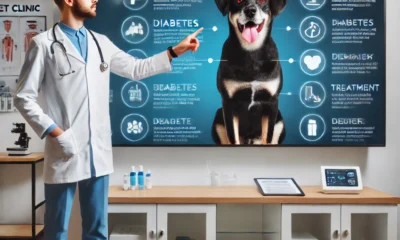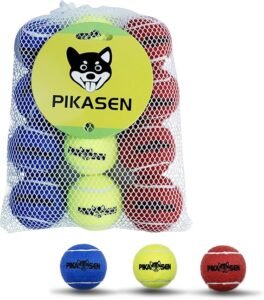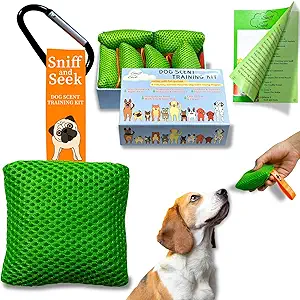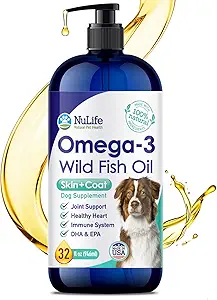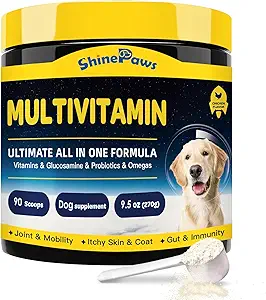Working Breeds
German Shepherd Unleashed: The Ultimate Guide to the World’s Most Versatile Dog

Introduction: More Than Just a Dog

🐾 German Shepherd Series – Article 1

German Shepherd Unleashed: The German Shepherd is not just a breed—it’s a legend. Whether it’s guarding homes, leading military missions, assisting the disabled, or starring in Hollywood films, the German Shepherd wears many hats. With a brilliant mind, noble stature, and unwavering loyalty, this breed is considered the gold standard among working dogs. In this all-encompassing guide, we’ll explore everything there is to know about this remarkable breed.
The Birth of a Legend: History and Origin
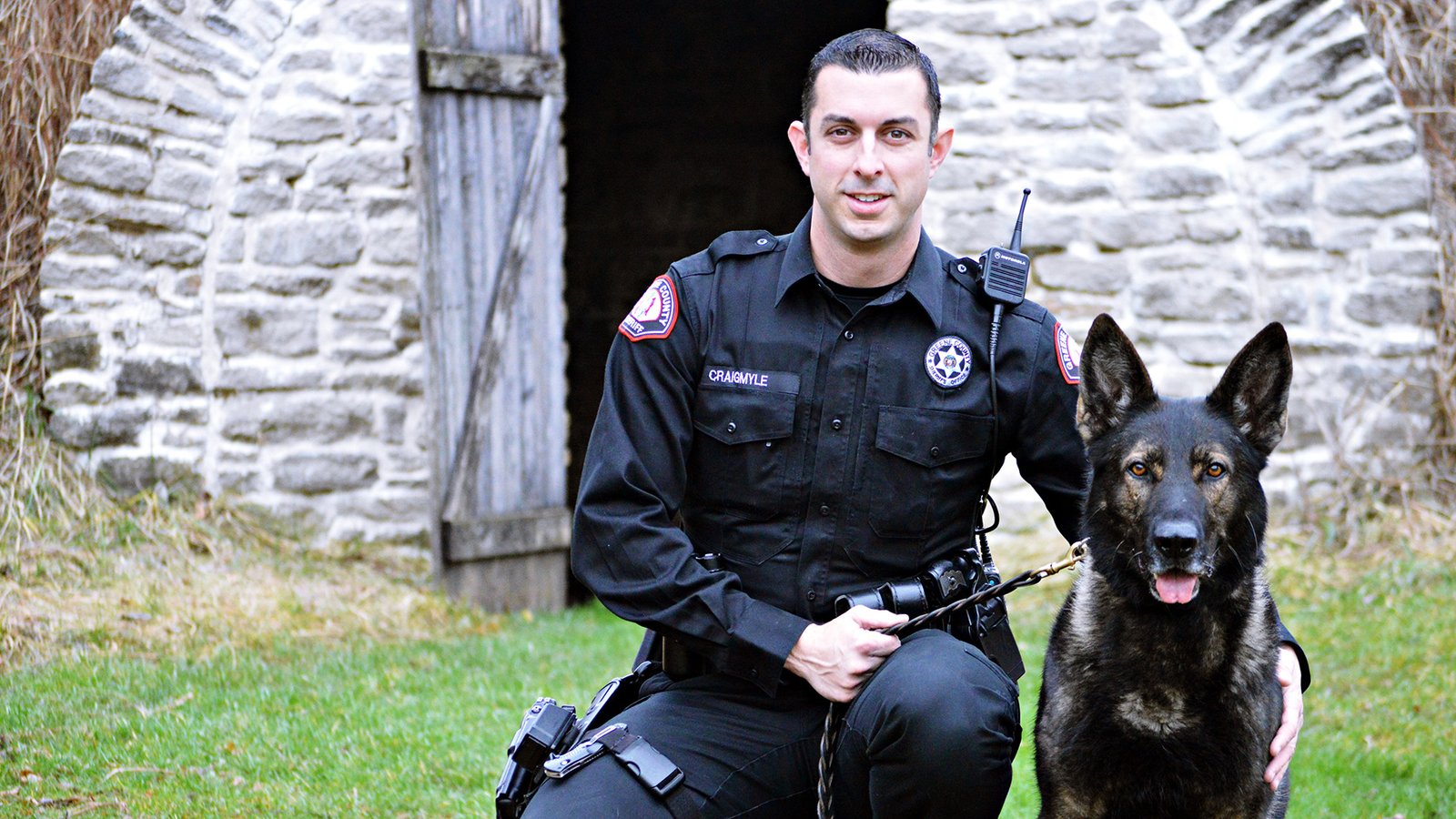
The German Shepherd was developed in the late 19th century by Captain Max von Stephanitz in Germany. Originally bred for herding and guarding sheep, von Stephanitz believed a dog’s value should lie in its utility and intelligence, not just its appearance. He found his ideal specimen in a dog named Horand von Grafrath, who became the first officially registered German Shepherd.
As industrialization reduced the need for herding dogs, von Stephanitz pushed for the breed’s use in police, military, and protection roles. The German Shepherd’s intelligence, trainability, and strong work ethic made it a natural fit.
By the early 20th century, German Shepherds were gaining worldwide fame, especially after their appearances in films like Rin Tin Tin and Strongheart. Despite anti-German sentiments during World Wars, the breed retained global admiration, sometimes marketed as the “Alsatian” in parts of Europe.
Breed Standard and Physical Traits

Height:
-
Males: 24–26 inches
-
Females: 22–24 inches
Weight:
-
Males: 65–90 lbs
-
Females: 50–70 lbs
Coat:
Double coat, dense and weather-resistant. Can be medium or long.
Common Colors of German Shepherd
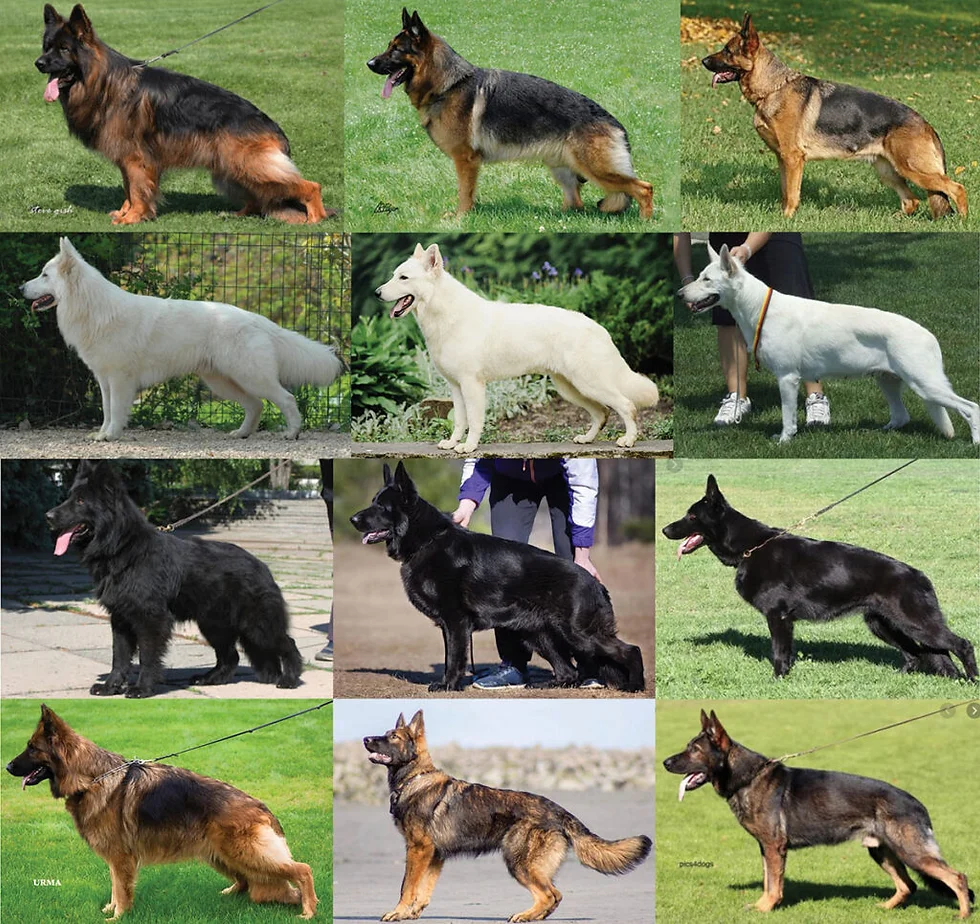
-
Black and tan (classic)
-
Black and red
-
Sable
-
Solid black
-
Bi-color
-
White (not accepted in all standards)
Build:
Athletic, muscular, and well-proportioned with a noble, alert posture.
Breed Standard Note:
The German Shepherd should display confidence, courage, and a willingness to serve. Movement should be smooth and effortless with strong rear propulsion.
Temperament: Loyalty Woven with Intelligence

The German Shepherd is highly intelligent, confident, courageous, and deeply loyal. They are:
-
Protective without being aggressive
-
Alert and responsive
-
Obedient and eager to work
-
Emotionally intuitive and affectionate with family
They require early socialization and firm, consistent training to thrive.
Abilities and Capacities: Built to Serve

German Shepherds are canine multitools, capable of excelling in roles that demand intelligence, strength, and agility:
1. Police & Military Work
Used worldwide in bomb detection, search-and-rescue, and tactical support.
2. Service Dogs
Highly dependable for guiding the visually impaired, alerting diabetics, and supporting PTSD patients.
3. Protection and Guarding
Exceptional at property protection and personal defense without being overly aggressive.
4. Search & Rescue
Their endurance and keen nose make them elite SAR dogs in natural disasters and crises.
5. Competitive Sports
Excel in agility, Schutzhund, obedience, herding, and tracking trials.
6. Acting & Media
From Rin Tin Tin to modern film roles, they shine on camera with expressive behavior and discipline.
Intelligence and Trainability

Ranked – 3 in intelligence by Dr. Stanley Coren, German Shepherds can learn new commands in less than five repetitions. Their ability to understand human emotion and solve problems makes them ideal in dynamic working environments.
Best Training Methods:
-
Positive reinforcement
-
Consistent routines
-
Mental challenges and puzzles
-
Early socialization
-
Purpose-driven exercises (they love having a job!)
Exercise and Mental Stimulation Needs
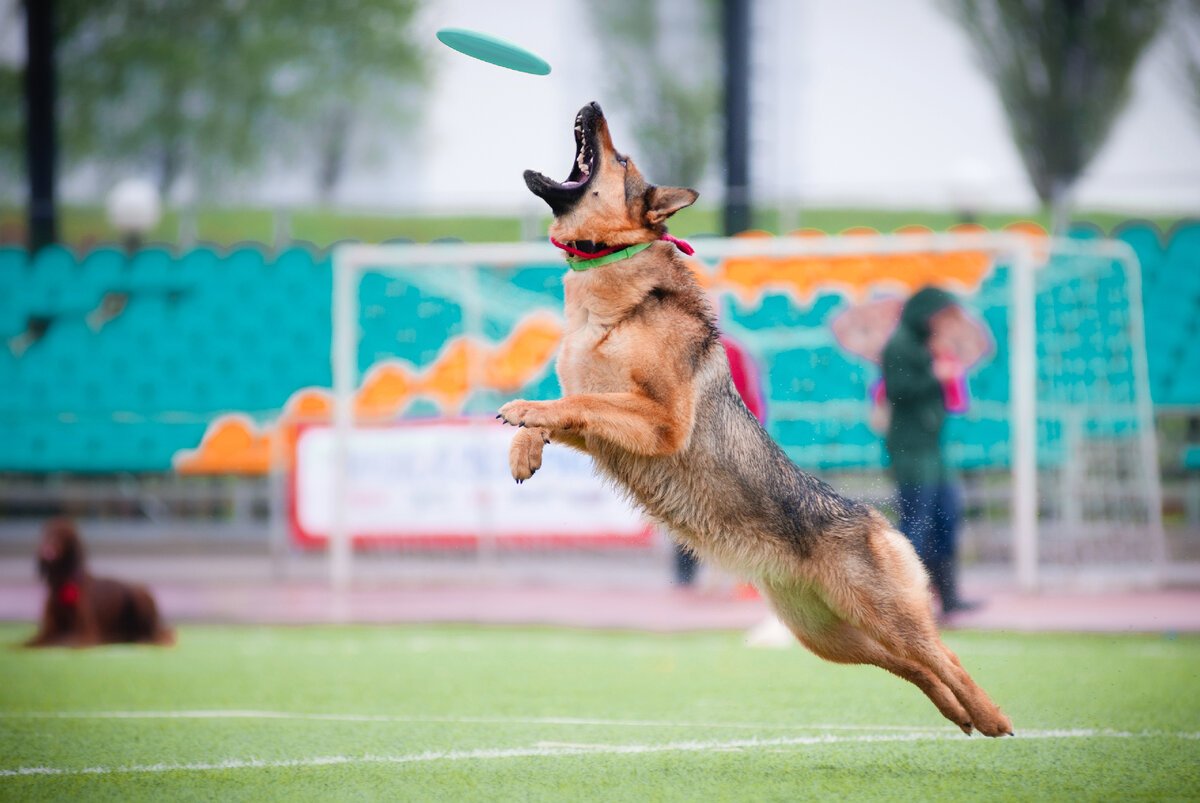
Daily Requirements:
-
1.5 to 2 hours of exercise
-
Mental games like hide-and-seek or scent work
-
Agility training or advanced obedience drills
Without proper outlets, boredom can lead to behavioral issues such as chewing, barking, or digging.
Health and Lifespan
Average Lifespan: 9–13 years
Common Health Issues:
-
Hip & elbow dysplasia
-
Degenerative Myelopathy
-
Gastric Dilatation-Volvulus (bloat)
-
Allergies and skin issues
-
Epilepsy
Preventive Care Tips:
-
Regular vet checkups
-
Maintain healthy weight
-
Joint supplements (glucosamine, chondroitin)
-
Avoid over-exercising during puppy growth stages
Feeding and Nutrition

Ideal Diet:
-
High-protein, moderate-fat content
-
Joint-supporting nutrients (omega-3s, turmeric, bone broth)
-
Fresh veggies, lean meats, and fortified kibble
Avoid feeding too many grains or fillers. Puppies need calcium for proper bone growth, but excess should be avoided.
Grooming Needs

-
Brushing: 3–4 times/week (daily during shedding)
-
Bathing: Every 6–8 weeks
-
Nail trimming: Monthly
-
Ear cleaning: Weekly
-
Shedding Level: High—this breed is often called the “German Shedder”
German Shepherd with Families

They are wonderful family companions when raised with proper training and socialization. They’re loyal, protective, and bond deeply with children. Early exposure to various sights, sounds, people, and animals is key to developing a well-rounded GSD.
Who Should Own a German Shepherd?
Ideal for:
-
Active individuals or families
-
Experienced dog owners
-
People interested in dog sports, protection, or service roles
Not ideal for:
-
Sedentary households
-
First-time dog owners without training commitment
-
Owners with limited time for exercise and stimulation
Fun Facts You May Not Know
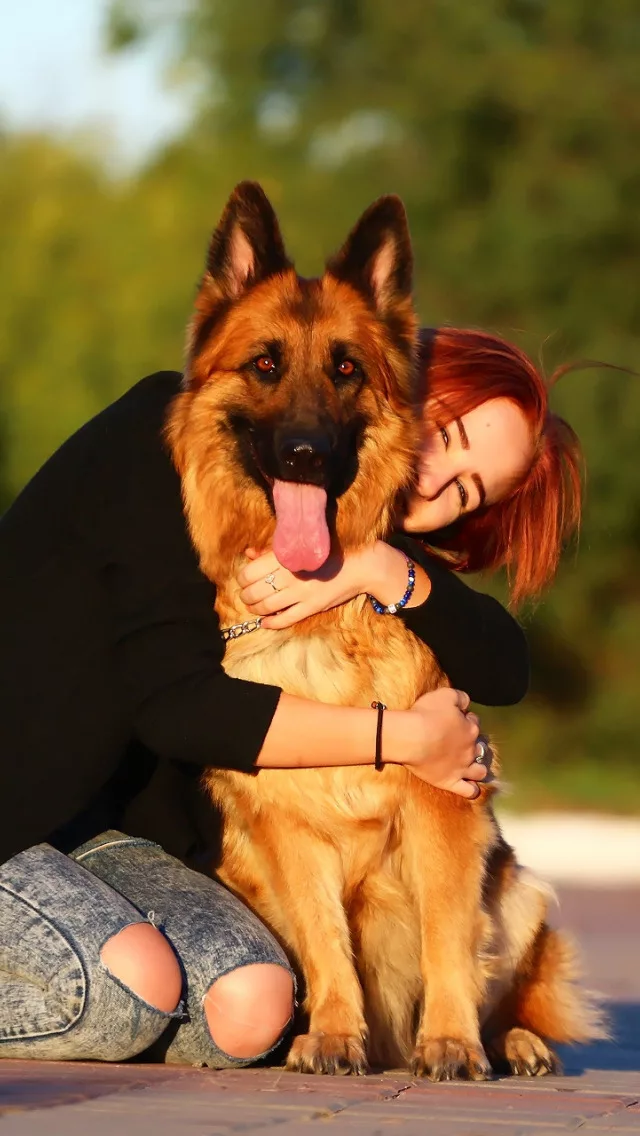
-
A German Shepherd named Filax of Lewanno was honored in WWI for leading 54 wounded soldiers to safety.
-
German Shepherds are trained in over 10 different languages worldwide.
-
President John F. Kennedy had a GSD named Clipper.
-
They can remember commands and tasks for year seven after not performing them for a long time.
Closing Statement : The Dog That Can Do It All
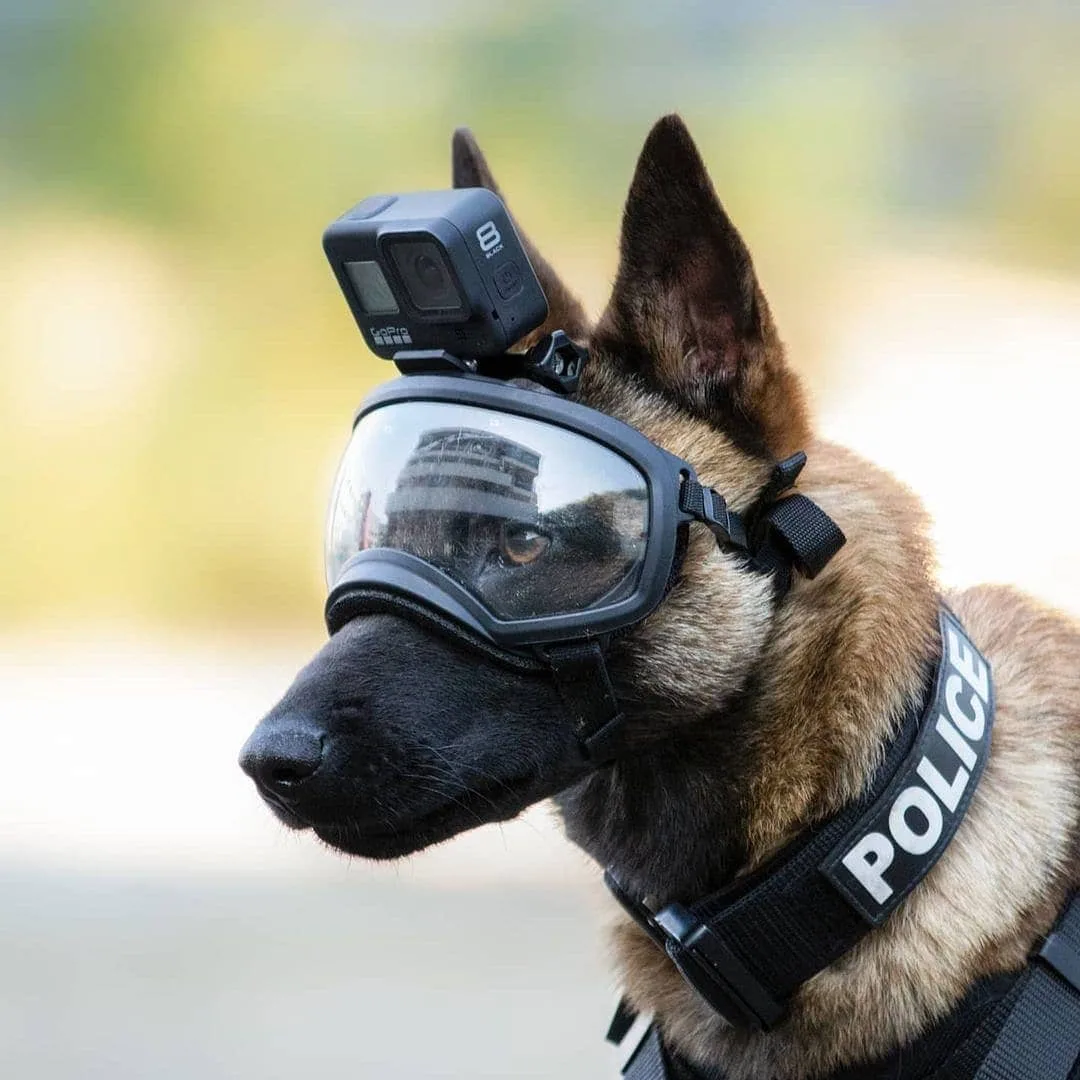
From the sheep pastures of 19th-century Germany to the front lines of modern police forces, the German Shepherd has proven itself time and again as the most versatile, intelligent, and loyal dog breed in the world. Whether you’re a potential owner, a dog enthusiast, or someone fascinated by canine abilities, the German Shepherd deserves your admiration.
If you’ve read this far, you now know everything you need to about this extraordinary breed. And if you’re still considering bringing one into your life a know that you’ll be gaining not just a pet, but a true partner.
Want more dog wisdom? Follow DogsReader on Facebook and Instagram. Visit www.dogsreader.com for expert care, breed encyclopedias, training guides, and real stories from dog lovers around the globe.
❓ Frequently Asked Questions
German Shepherd Unleashed: The Ultimate Guide to the World’s Most Versatile Dog
1. Are German Shepherds good for first-time dog owners?
Yes, but only if you’re committed to training, exercise, and consistent leadership. GSDs are intelligent and loyal, but they require structure and mental stimulation.
2. How much exercise does a German Shepherd need daily?
An adult German Shepherd needs at least 60–90 minutes of physical activity daily, including walks, fetch, agility, or structured play. Mental exercise is equally important.
3. Are German Shepherds aggressive?
Not inherently. With proper socialization and training, German Shepherds are confident, composed, and loyal. Poor handling or neglect can lead to aggression, as with any breed.
4. How long do German Shepherds live?
The average lifespan is 9 to 13 years, depending on genetics, diet, exercise, and healthcare. Some healthy GSDs live even longer with proper care.
5. Do German Shepherds shed a lot?
Yes—GSDs are heavy shedders year-round, with even more intense shedding during spring and fall. Weekly brushing (or more) is essential to manage loose fur.
6. Are German Shepherds good with children?
Yes, when raised and trained properly. They are protective, gentle, and form strong bonds with kids. Early socialization is key to building a safe family environment.
7. Can German Shepherds live in apartments?
Yes, if they get enough exercise and mental engagement. However, a home with a yard is more ideal. Apartment living requires daily activity and commitment.
8. What’s the difference between a Working Line and a Show Line German Shepherd?
-
Working Line: Higher energy, drive, and endurance; used in police, military, and protection work.
-
Show Line: Heavier build, sloped back, calmer temperament; bred for conformation and companionship.
9. What health problems are common in German Shepherds?
-
Hip and elbow dysplasia
-
Degenerative Myelopathy
-
EPI (Exocrine Pancreatic Insufficiency)
- Bloat (Gastric Dilatation Volvulus)
- Regular vet checks and responsible breeding can minimize risks.
10. How do I find a reputable German Shepherd breeder?
Look for breeders who:
Provide health clearances
Allow home visits
Focus on temperament and structure
Don’t rush the sale
Avoid puppy mills or sellers with no transparency.
Working Breeds
Mental Games for Dogs: Brain Boosting Activities by Age & Breed Type

Introduction: Why Mental Stimulation is Essential for Dogs
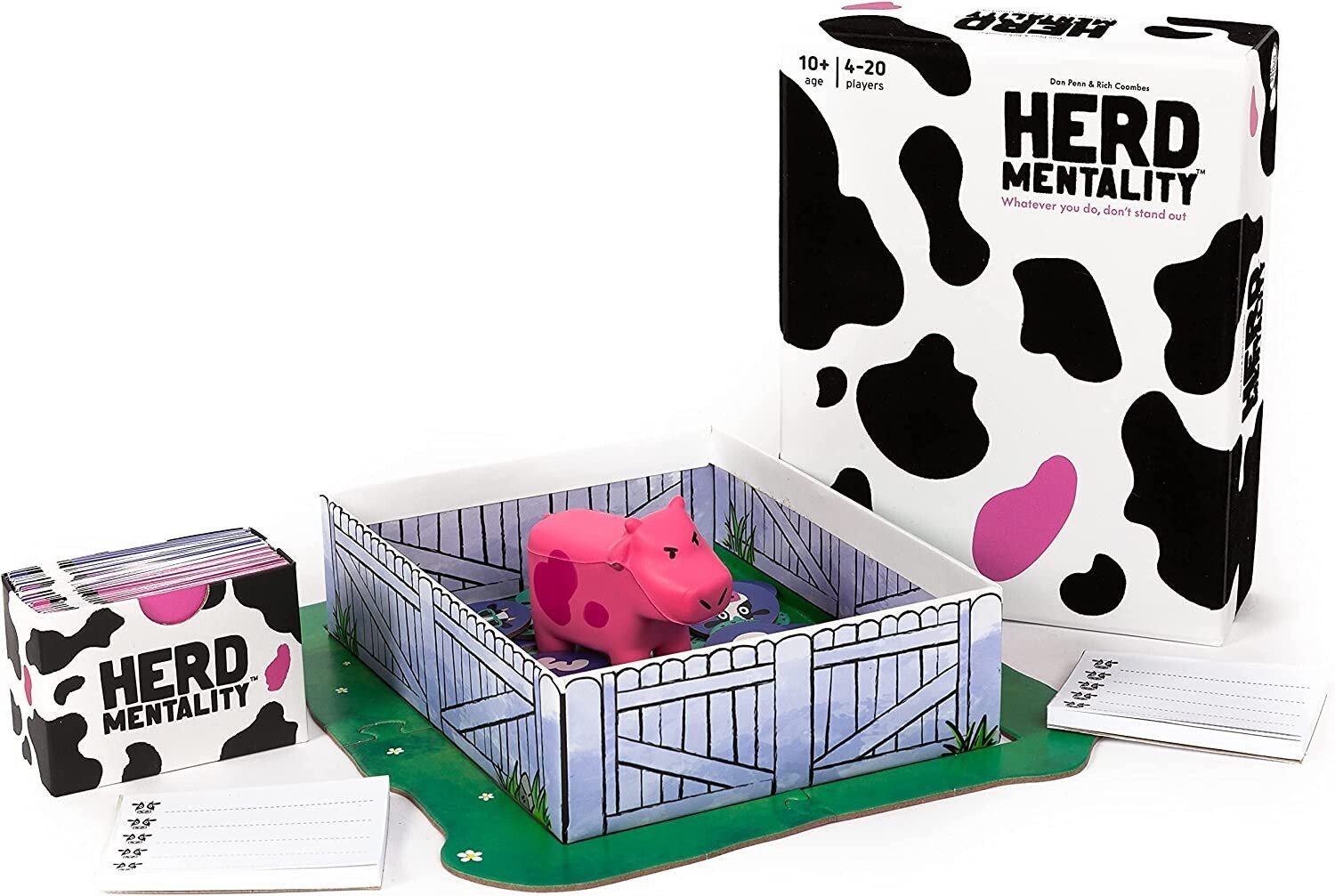
Mental Games for Dogs: Just like humans, dogs need mental stimulation to stay sharp, happy, and well-behaved. While daily walks and physical exercise are important, mental workouts play an equally vital role in preventing boredom, anxiety, and behavioral issues. Whether you have a playful puppy, a working breed with boundless energy, or a senior dog needing gentle challenges, there’s a brain-boosting activity tailored to every canine.
In this comprehensive guide, we’ll explore the best mental games by age group and breed type, ensuring every dog gets the stimulation they crave.
Puppies (8 Weeks – 6 Months)

🧠 What They Need:
Basic problem-solving, sensory development, and bonding.
✅ Top Mental Games:
-
Name That Toy: Teach the names of different toys by repetition and reward.
-
Mini Puzzle Feeders: Use soft, puppy-safe feeders to challenge food retrieval.
-
Towel Treat Roll: Hide treats inside a rolled towel and let them sniff and unroll it.
-
Follow the Leader: Teach basic commands and reward when they follow correctly.
-
Hide and Seek: Hide behind furniture and call their name to promote recall and excitement.
🕒 Session Time: 5–10 minutes per game (2–3 times a day)
Adult Dogs (7 Months – 7 Years)

🧠 What They Need:
Skill building, daily mental stimulation, and cognitive enrichment.
✅ Top Mental Games:
-
Shell Game: Hide a treat under one of three cups and shuffle them.
-
Interactive Toys: Invest in smart dog toys that respond to actions.
-
Find the Object: Hide their favorite toy and let them search.
-
Command Challenges: Mix known and new commands rapidly to test their memory.
-
Obstacle Courses: Use cushions, cones, or boxes to create a mini agility circuit indoors.
🕒 Session Time: 15–30 minutes per game (once or twice a day)
Senior Dogs (8+ Years)

🧠 What They Need:
Memory support, low-impact games, and calming engagement.
✅ Top Mental Games:
-
Gentle Nose Work: Place strong-scented treats around the room for easy searching.
-
Slow Puzzle Toys: Use larger, easy-to-navigate feeders.
-
Memory Recall: Practice commands learned in earlier years.
-
Scent Trail: Drag a treat along the floor and let them track it slowly.
-
Soft Hide & Seek: Hide plush toys or lightly cover items with blankets.
🕒 Session Time: 5–15 minutes per game (once daily or every other day)
Quick DIY Game Ideas for Every Home

| Game | Materials Needed | Best For |
|---|---|---|
| Muffin Tin Puzzle | Muffin tin,
|
Small & Medium Breeds |
| Sock Snuffle | Old sock,
|
Puppies & Seniors |
| Agility ladder | Agility ladder | Working & Large Breeds |
| Toy Box Memory | Multiple toys, names, and commands | Adult Dogs |
| Scent Trail | Treats, string trail or dotted scent | Hound Breeds |
By Breed Type: Targeted Mental Stimulation
🐶 Small Breeds (Chihuahua, Pomeranian, Shih Tzu, etc.)
Small dogs often love puzzles but tire quickly.
-
Toy Name Training
-
Mini Treat Mazes
-
Snuffle Mats
🕒 Time: 10–15 minutes/day
🐕 Medium Breeds (Beagle, Cocker Spaniel, Border Collie)
Highly intelligent and driven, especially in scent and chase.
-
Scent Games
-
Find-the-Human
-
Agility Jumps (Low Height)
🕒 Time: 20–30 minutes/day
🐕🦺 Large Breeds (Labrador, German Shepherd, Golden Retriever)
They thrive on interactive challenges and learning roles.
-
Fetch + Obedience Combos
-
Interactive Memory Toys
-
Command + Reward Cycles
🕒 Time: 30–40 minutes/day
🦮 Giant Breeds (Great Dane, Mastiff, Saint Bernard)
Prefer slow-paced, gentle games due to joint care.
-
Tracking Scent Trails
-
Kong-Filled Treat Discovery
-
Low Impact Puzzle Boards
🕒 Time: 15–20 minutes/day
🚨 Working Dogs (Doberman, Husky, Rottweiler, Belgian Malinois)
Need daily jobs or tasks to prevent restlessness.
-
Job Commands (Guard, Fetch Keys, Bring Remote)
-
Search + Rescue Simulations
-
Object Identification Challenges
🕒 Time: 45–60 minutes/day
🧭 Hound Breeds (Basset, Bloodhound, Beagle)
Excellent trackers that enjoy scent-heavy games.
-
Advanced Sniffing Games
-
Scent Mapping on Grass
-
Treasure Hunts
🕒 Time: 30 minutes/day
🐾 Terrier Breeds (Jack Russell, Westie, Bull Terrier)
Energetic and curious—mental stimulation helps avoid destructiveness.
-
Burrow Boxes (Hidden Toys in Soft Boxes)
-
Mini Digging Zones (in blankets or safe materials)
-
Problem Solving Games (Puzzle toys)
🕒 Time: 25–30 minutes/day
Mental Exercise Safety Tips
- Always supervise your dog, especially with puzzle toys.
- Keep sessions short and fun.
- End on a positive note—never punish for confusion.
- Rotate games weekly to avoid boredom.
- Adjust games as your dog ages or develops new needs.
Final Thoughts: Sharpen Their Minds, Strengthen Your Bond
Mental games don’t just tire your dog—they fulfill their instincts, challenge their minds, and build stronger trust with you. Whether you have a toy-sized pup or a powerful working dog, adding a few mental challenges each day makes all the difference.
DogsReader is your trusted partner in building a smarter, happier, and healthier life for your dog. 💡🐶
FAQs
Q1: Are mental games better than physical exercise?
A: Both are essential! Mental games complement physical activity and reduce anxiety and boredom.
Q2: Can senior dogs learn new games?
A: Absolutely! Gentle mental games help preserve memory and cognitive function.
Q3: How often should I change the mental games?
A: Weekly variation is great! Dogs get bored with repetition just like humans do.
Q4: What if my dog isn’t interested in puzzle toys?
A: Start easy and use high-value treats. Gradually increase difficulty over time.
Q5: Can I create my own mental games?
A: Yes! Dogs love novelty. Be creative with safe, dog-friendly household items.
Working Breeds
Brittany Dog: Breed Types By Countries

A Comprehensive Guide
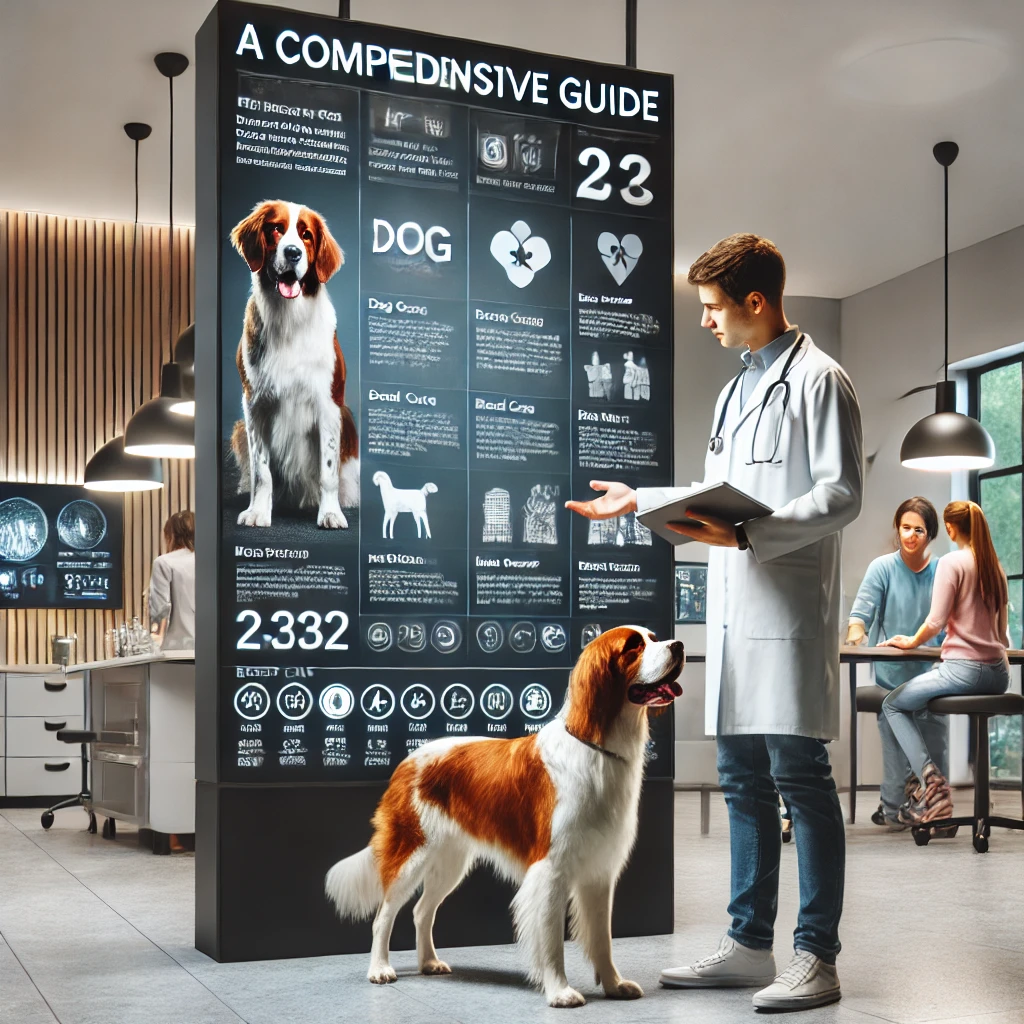
The Brittany Dog: is a versatile and energetic breed known for its intelligence, agility, and friendly nature. Originally bred as a hunting dog, the Brittany has become a beloved companion for families and active individuals. This guide covers the breed’s history, habits, temperament, grooming needs, exercise requirements, and essential supplements for males and pregnant females.
For more information regarding 4 seasonal cxcercieses of all dog breeds recommended by the doctors and experts,you can visit our youtube channel:
Brief History of the Brittany Dog
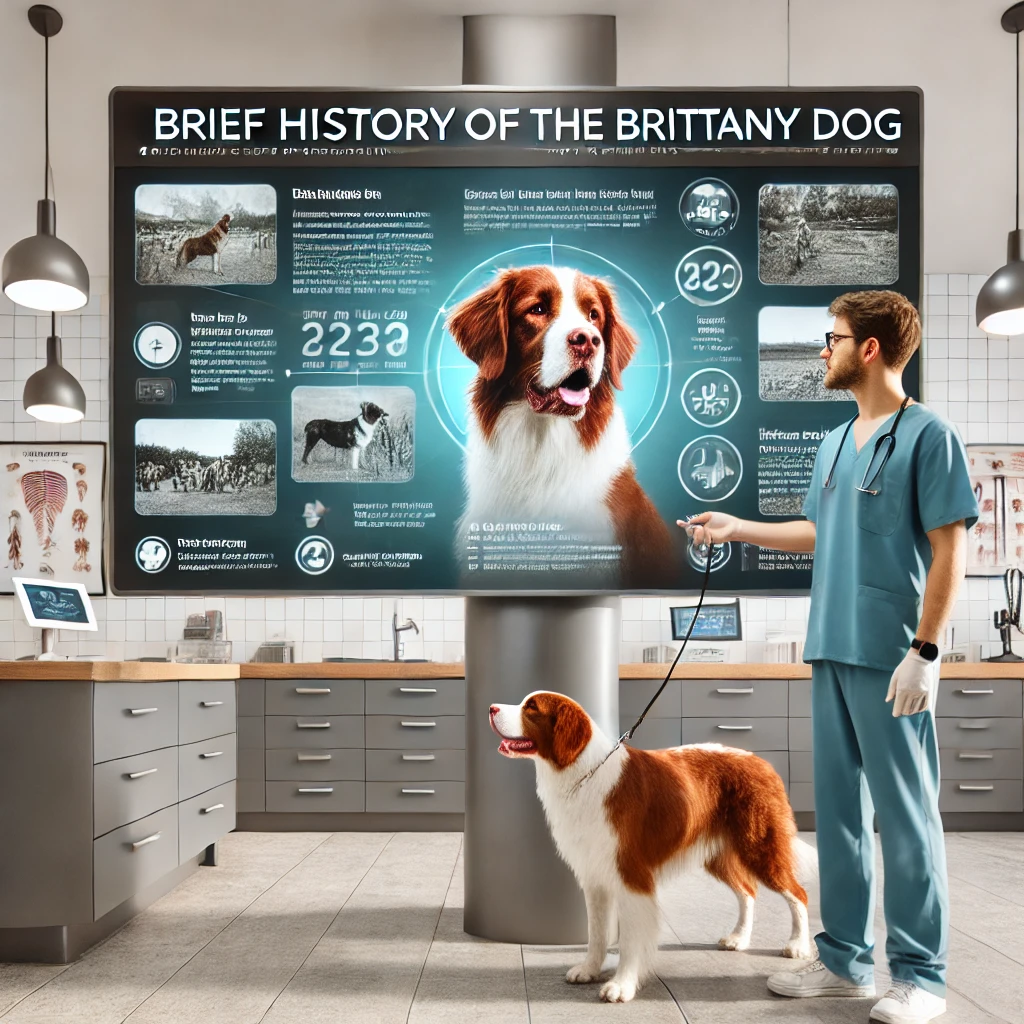
- Origin:
- The Brittany originated in the Brittany region of France in the 17th century.
- Purpose:
- Bred as a gun dog for hunting birds and small game.
- Recognition:
- Officially recognized by the American Kennel Club (AKC) in 1934.
- Popularity:
- Known for its versatility in hunting, agility, and companionship.
Brittany Dog by Countries

| Country | Type | Characteristics |
|---|---|---|
| France | Original Brittany (Epagneul Breton) | Smaller, compact, and highly skilled in hunting. |
| United States | American Brittany | Slightly larger, bred for both hunting and show purposes. |
| United Kingdom | Brittany Spaniel | Similar to the French type, often used for field trials and hunting. |
Brittany Dog Breed Types
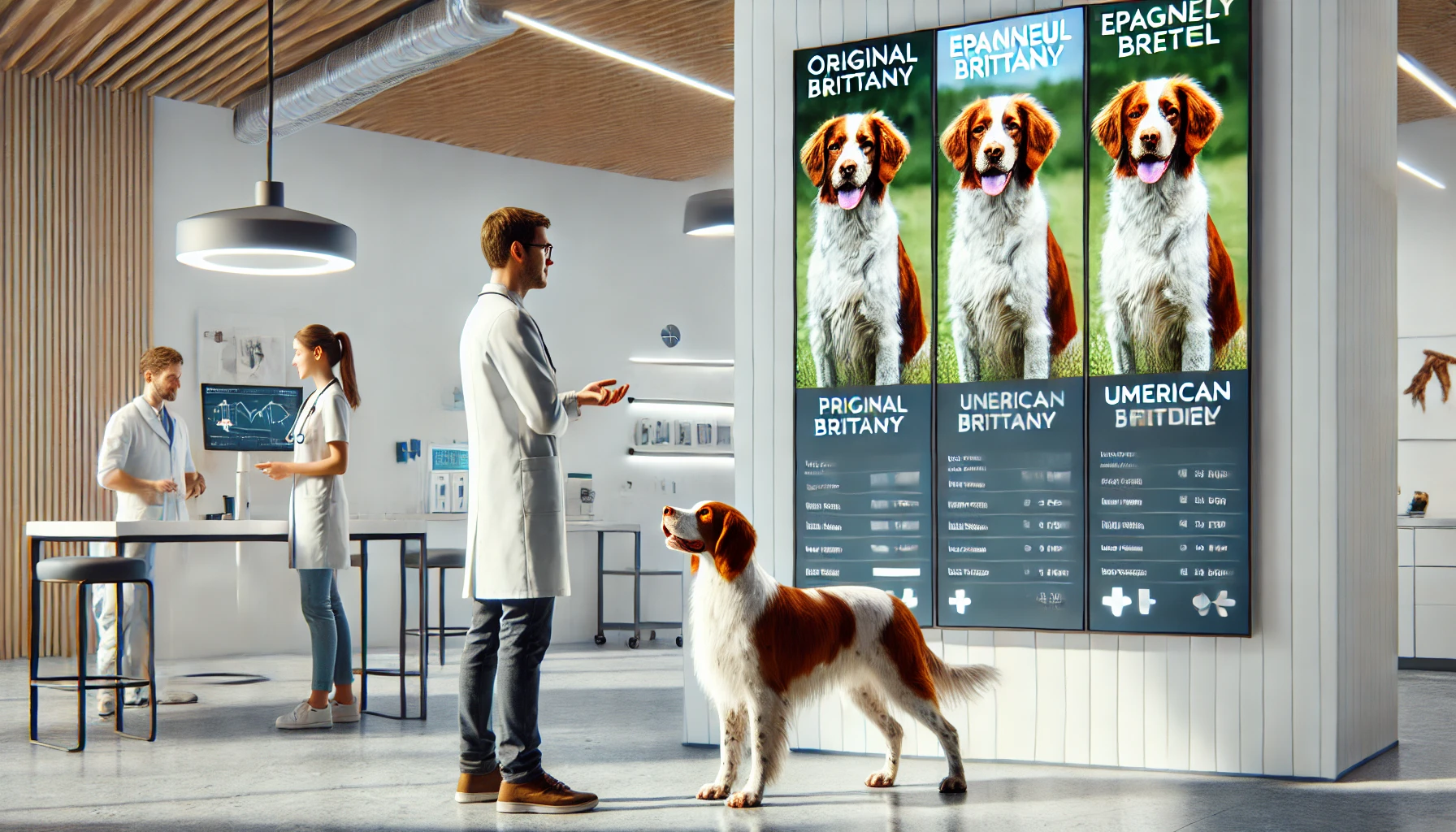
The Brittany is a versatile and energetic breed with variations based on regional breeding practices and purposes. Below is a breakdown of the main types of Brittany dogs, their characteristics, and their uses.
1. French Brittany (Epagneul Breton)

- Origin:
- Brittany region of France.
- Size:
- Smaller and more compact than the American Brittany.
- Weight:
- 30-40 pounds (13.5-18 kg).
- Height:
- 17.5-20.5 inches (44-52 cm).
- Coat:
- Medium-length, dense, and slightly wavy.
- Colors:
- Orange and white, liver and white, black and white (rare).
- Temperament:
- Highly skilled in hunting, intelligent, and energetic.
- Uses:
- Primarily bred for hunting birds and small game.
2. American Brittany
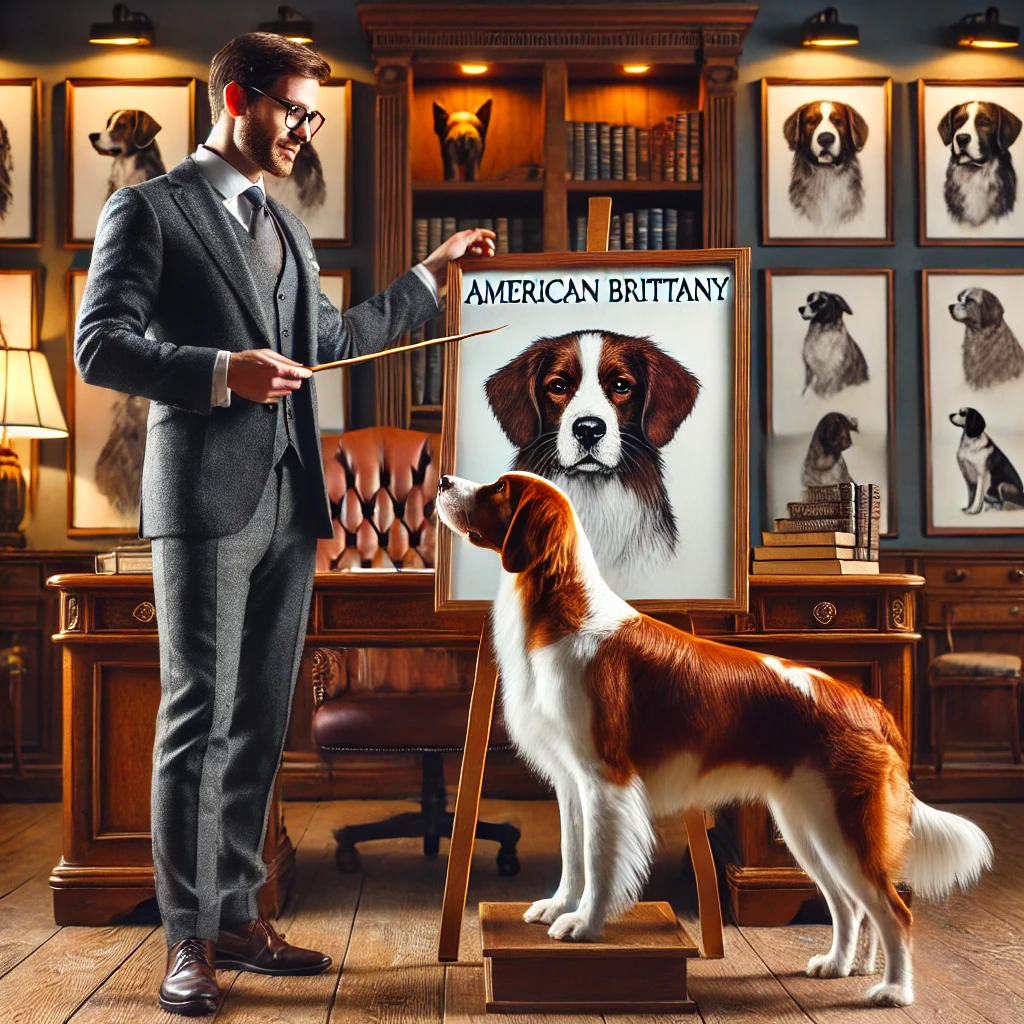
- Origin:
- United States.
- Size:
- Slightly larger and more robust than the French Brittany.
- Weight:
- 30-40 pounds (13.5-18 kg).
- Height:
- 17.5-20.5 inches (44-52 cm).
- Coat:
- Medium-length, dense, and slightly wavy.
- Colors:
- Orange and white, liver and white, roan patterns.
- Temperament:
- Friendly, intelligent, and versatile.
- Uses:
- Bred for both hunting and show purposes.
3. Brittany Spaniel (Traditional Type)
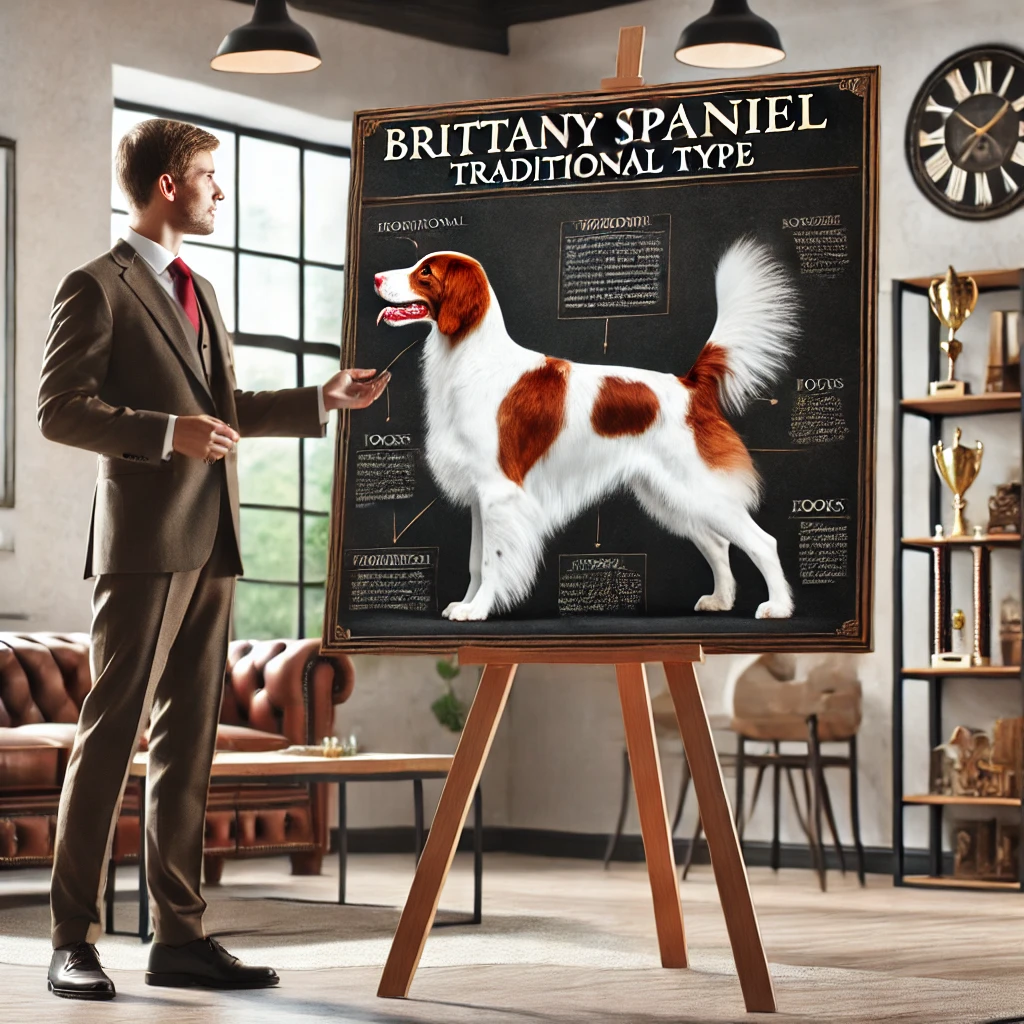
- Origin:
- United Kingdom and other European countries.
- Size:
- Similar to the French Brittany.
- Weight:
- 30-40 pounds (13.5-18 kg).
- Height:
- 17.5-20.5 inches (44-52 cm).
- Coat:
- Medium-length, dense, and slightly wavy.
- Colors:
- Orange and white, liver and white, tricolor (white, orange, and liver).
- Temperament:
- Energetic, intelligent, and excellent in field trials.
- Uses:
- Primarily used for hunting and field trials.
Key Differences Between Brittany Types
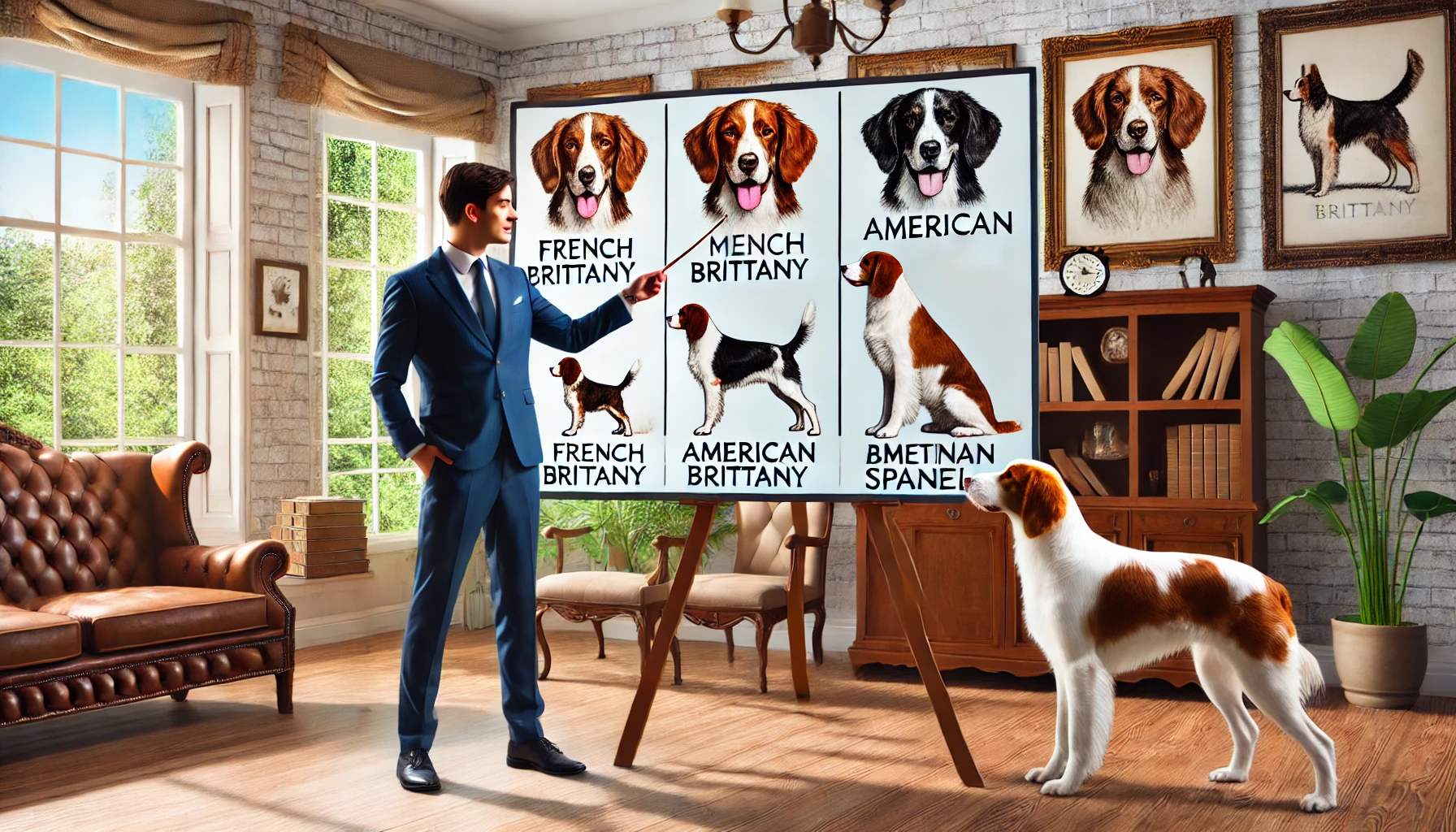
| Aspect | French Brittany | American Brittany | Brittany Spaniel |
|---|---|---|---|
| Size | Smaller and more compact. | Slightly larger and more robust. | Similar to French Brittany. |
| Coat Colors | Orange and white, liver and white, black and white (rare). | Orange and white, liver and white, roan patterns. | Orange and white, liver and white, tricolor. |
| Primary Use | Hunting birds and small game. | Hunting and show purposes. | Hunting and field trials. |
| Temperament | Highly skilled in hunting, intelligent, and energetic. | Friendly, intelligent, and versatile. | Energetic, intelligent, and excellent in field trials. |
Common Traits in Brittany

While all Brittany types share common traits like intelligence, energy, and a friendly nature, they differ slightly in size, coat colors, and primary uses. Whether you’re looking for a hunting companion, a show dog, or a family pet, the Brittany is a versatile and loving breed that adapts well to various roles.
Habits of the Brittany Dog
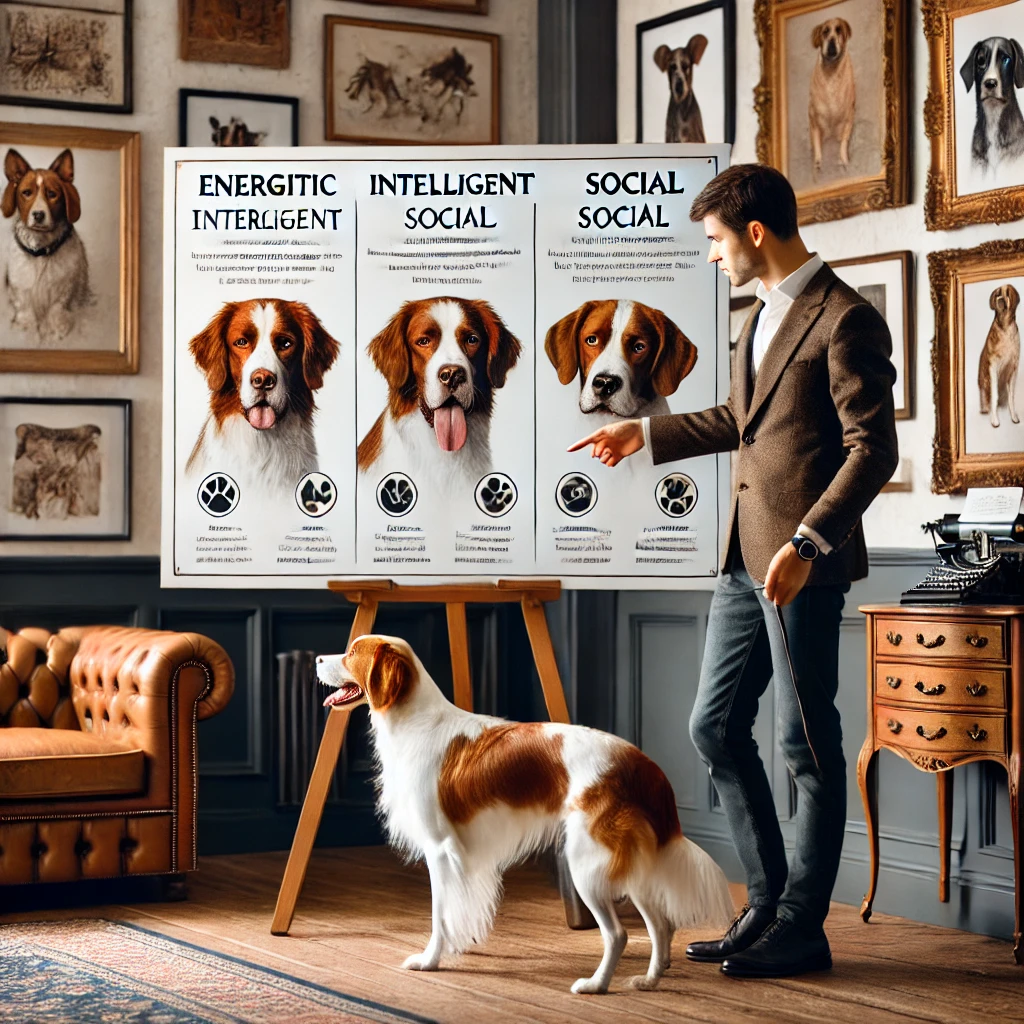
- Energetic:
- Requires plenty of exercise and mental stimulation.
- Intelligent:
- Quick learners, excel in obedience and agility training.
- Social:
- Thrives on human interaction and enjoys being part of family activities.
- Hunting Instincts:
- Strong prey drive; may chase small animals.
Human and Family Friendliness

- Human-Friendly:
- Extremely affectionate and loyal to their owners.
- Child-Friendly:
- Gentle and patient with children, making them excellent family pets.
- Other Pets:
- Generally good with other dogs but may chase smaller pets due to their hunting instincts.
Brittany Dogs Body Colors by Country

| Country | Common Colors |
|---|---|
| France |
|
| United States |
|
| United Kingdom |
|
Temperament and Personality

- Friendly:
- Outgoing and sociable with people and other dogs.
- Energetic:
- Requires regular exercise to stay happy and healthy.
- Intelligent:
- Easy to train and eager to please.
- Sensitive:
- Responds best to positive reinforcement and gentle training methods.
Life Span of Male and Female Brittany Dogs

| Gender | Average Life Span |
|---|---|
| Male | 12-14 years |
| Female | 12-14 years |
Note: There is no significant difference in life span between males and females.
Grooming Needs
- Coat Care:
- The Brittany has a medium-length, dense coat that requires weekly brushing to remove loose hair and prevent matting.
- Bathing:
- Bathe as needed (every 6-8 weeks) to keep the coat clean and healthy.
- Ears:
- Check and clean ears weekly to prevent infections.
- Nails:
- Trim nails every 2-3 weeks to avoid overgrowth.
- Teeth:
- Brush teeth 2-3 times a week to maintain oral health.
Exercise Requirements

- Daily Exercise:
- At least 60-90 minutes of vigorous activity, such as running, hiking, or playing fetch.
- Mental Stimulation:
- Engage in activities like agility training, puzzle toys, or obedience training.
- Hunting or Field Work:
- Ideal for Brittanys, as it fulfills their natural instincts.
Supplements for Male Brittany Dogs
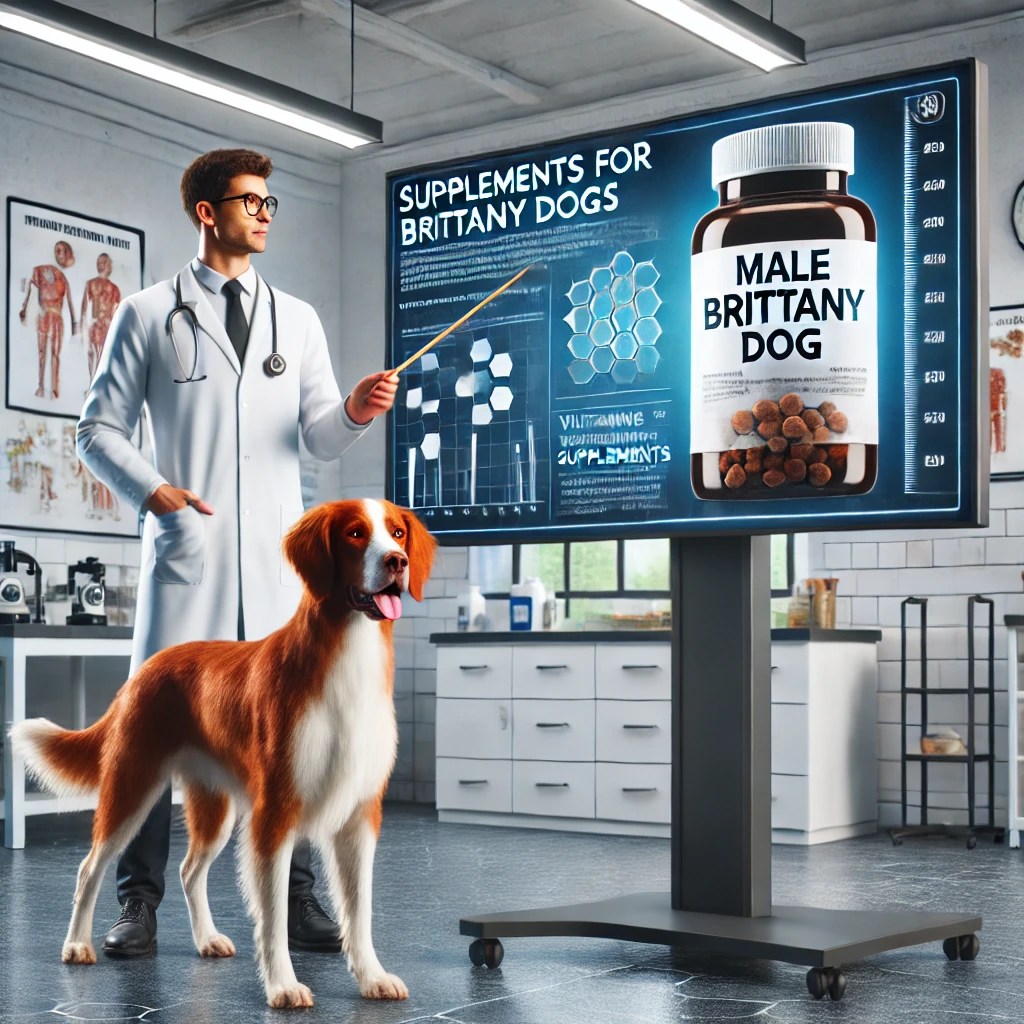
Essential Supplements for Male and Pregnant Female Brittany Dogs
Supplements for Pregnant Female Brittany Dogs

Closing Statement

The Brittany is a lively, intelligent, and affectionate breed that thrives in active households. With proper care, grooming, exercise, and nutrition, Brittanys make excellent companions for families, hunters, and outdoor enthusiasts. Whether you’re looking for a hunting partner or a loyal family pet, the Brittany is a versatile and loving choice.
(FAQs) About Brittany Dogs

Below are detailed answers to common questions about Brittany dogs, including their temperament, care, and suitability as family pets.
1. What is a Brittany dog?
The Brittany is a medium-sized hunting dog known for its intelligence, energy, and friendly nature. It originated in France and is popular for both hunting and companionship.
2. Are Brittany dogs good with children?
Yes, Brittanys are gentle, patient, and affectionate with children, making them excellent family pets.
3. How much exercise does a Brittany need?
Brittanys require 60-90 minutes of vigorous exercise daily, such as running, hiking, or playing fetch. They also need mental stimulation through training or puzzle toys.
4. Are Brittany dogs easy to train?
Yes, Brittanys are highly intelligent and eager to please, making them easy to train. They respond best to positive reinforcement and gentle methods.
5. Do Brittany dogs shed?
Yes, Brittanys have a medium-length coat that sheds moderately. Weekly brushing can help manage shedding.
6. Are Brittany dogs good with other pets?
Brittanys generally get along well with other dogs but may chase smaller pets due to their strong hunting instincts.
7. What is the life span of a Brittany dog?
The average life span of a Brittany is 12-14 years.
8. Do Brittany dogs bark a lot?
Brittanys may bark to alert their owners or when excited, but they are not excessive barkers. Proper training can help manage barking.
9. Are Brittany dogs hypoallergenic?
No, Brittanys are not hypoallergenic. They shed moderately and may not be suitable for people with severe allergies.
10. What colors do Brittany dogs come in?
Common colors include orange and white, liver and white, and roan patterns. Tricolor (white, orange, and liver) is also seen in some regions.
11. Are Brittany dogs good for first-time owners?
Yes, Brittanys are friendly and easy to train, making them suitable for first-time owners who can meet their exercise and mental stimulation needs.
12. How often should I groom my Brittany?
- Brush their coat weekly to remove loose hair and prevent matting.
- Bathe them every 6-8 weeks.
- Clean their ears and trim their nails weekly.
13. Can Brittany dogs live in apartments?
Brittanys are highly energetic and do best in homes with access to a yard or open space. Apartment living is possible but requires ample daily exercise.
14. Do Brittany dogs have health issues?
Brittanys are generally healthy but may be prone to:
- Hip dysplasia.
- Epilepsy.
- Ear infections (due to their floppy ears).
15. Are Brittany dogs good hunting dogs?
Yes, Brittanys are excellent hunting dogs, known for their agility, intelligence, and strong prey drive.
16. How much does a Brittany dog cost?
The cost of a Brittany puppy ranges from between $800 and $2,500, depending on the breeder and lineage.
17. Do Brittany dogs need supplements?
Supplements like omega-3 fatty acids, glucosamine, and probiotics can support their overall health. Pregnant females may need prenatal vitamins and calcium.
18. Are Brittany dogs good for seniors?
Brittanys are highly energetic and may be too active for seniors unless the owner can provide sufficient exercise and mental stimulation.
19. Can Brittany dogs be left alone?
Brittanys are social dogs and may develop separation anxiety if left alone for long periods. They thrive in homes where they receive plenty of attention.
20. What is the difference between a Brittany and a Brittany Spaniel?
The terms are often used interchangeably, but “Brittany Spaniel” is an older name. Modern Brittanys are simply called “Brittanys” and are bred for both hunting and companionship.
Working Breeds
Heart Failure in Dogs: Causes, Symptoms, and Care

A Comprehensive Guide

Heart Failure in Dogs: is a serious condition that affects dogs of all ages and breeds. It occurs when the heart is unable to pump blood effectively, leading to a buildup of fluid in the lungs, abdomen, or other tissues. Understanding the causes, symptoms, and stages of heart failure is crucial for providing the best care for your furry friend. This article covers everything you need to know about heart failure in dogs, including enlarged heart, signs of a dog dying of heart failure, heart disease, stages of congestive heart failure, and life expectancy.
For more information regarding 4 seasonal cxcercieses of all dog breeds recommended by the doctors and experts,you can visit our youtube channel:
What is Heart Failure in Dogs?

Heart failure occurs when the heart cannot meet the body’s demands for blood and oxygen. It can result from various underlying conditions, such as:
- Valvular Disease:
- Degeneration of heart valves (common in small breeds).
- Dilated Cardiomyopathy (DCM):
- Enlargement and weakening of the heart muscle (common in large breeds).
- Congenital Defects:
- Birth defects affecting the heart’s structure.
- Heartworm Disease:
- Caused by parasitic worms in the heart and lungs.
Enlarged Heart in Dogs

An enlarged heart, or cardiomegaly, is a common symptom of heart disease. It can result from:
- Dilated Cardiomyopathy (DCM):
- The heart muscle becomes thin and weak, causing the heart to enlarge.
- Hypertrophic Cardiomyopathy (HCM):
- The heart muscle thickens, reducing its ability to pump blood.
- Chronic Valve Disease:
- Leaky heart valves cause the heart to work harder and enlarge over time.
Signs of Heart Failure in Dogs
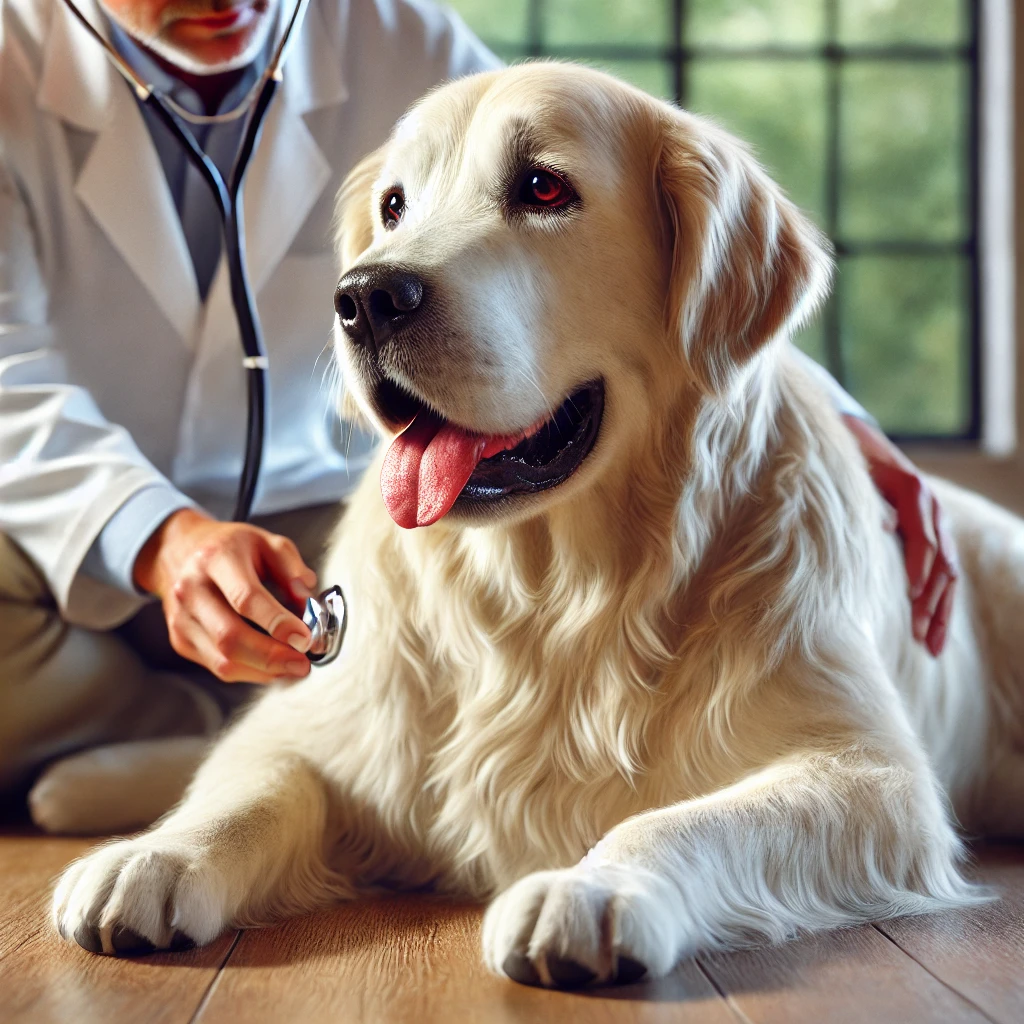
The symptoms of heart failure depend on the severity and stage of the condition. Common signs include:
- Coughing:
- Especially at night or after exercise.
- Difficulty Breathing:
- Rapid or labored breathing.
- Lethargy:
- Reduced energy and reluctance to exercise.
- Fainting or Collapse:
- Due to poor blood flow to the brain.
- Swelling:
- Fluid buildup in the abdomen (ascites) or limbs (edema).
- Weight Loss:
- Despite a normal or increased appetite.
Signs of a Dog Dying of Heart Failure

In the final stages of heart failure, dogs may exhibit:
- Severe Difficulty Breathing:
- Gasping or open-mouth breathing.
- Blue or Pale Gums:
- Due to lack of oxygen.
- Cold Extremities:
- Paws and ears may feel cold.
- Loss of Appetite:
- Refusal to eat or drink.
- Extreme Weakness:
- Inability to stand or walk.
- Restlessness or Confusion:
- Due to discomfort or lack of oxygen.
Heart Disease in Dogs

Heart disease refers to any condition that affects the heart’s structure or function. Common types include:
- Valvular Disease:
- Degeneration of heart valves, common in older small breeds.
- Dilated Cardiomyopathy (DCM):
- Enlargement and weakening of the heart muscle, common in large breeds.
- Congenital Defects:
- Birth defects like patent ductus arteriosus (PDA) or ventricular septal defect (VSD).
- Heartworm Disease:
- Caused by parasitic worms in the heart and lungs.
Canine Congestive Heart Failure Stages

Congestive heart failure (CHF) progresses through four stages:
- Stage A: At-risk dogs with no symptoms (e.g., certain breeds prone to heart disease).
- Stage B1: Structural heart disease is present, but no symptoms.
- Stage B2: Structural heart disease with mild symptoms (e.g., occasional coughing).
- Stage C: Overt heart failure with significant symptoms (e.g., coughing, difficulty breathing).
- Stage D: End-stage heart failure with severe symptoms and poor quality of life.
How Long Can a Dog Live with Congestive Heart Failure?

The life expectancy of a dog with congestive heart failure depends on:
- The Underlying Cause:
- Dogs with valvular disease may live longer than those with DCM.
- The Stage of CHF:
- Early-stage dogs can live for 1-2 years with proper treatment, while end-stage dogs may only survive weeks to months.
- Treatment and Management:
- Medications, diet, and lifestyle changes can improve quality of life and extend survival time.
Treatment and Management of Heart Failure in Dogs

-
Medications:
- Diuretics: Reduce fluid buildup (e.g., furosemide).
- ACE Inhibitors: Improve blood flow (e.g., enalapril).
- Pimobendan: Strengthens the heart’s pumping ability.
-
Diet:
- Low-sodium diets to reduce fluid retention.
- High-quality protein and omega-3 fatty acids for overall health.
- Lifestyle Changes:
- Moderate exercise to maintain muscle tone.
- Avoid stress and extreme temperatures.
- Regular Vet Check-Ups: Monitor the condition and adjust treatment as needed.
Supplements to Support Heart Health in Adult and Senior Dogs

This table outlines supplements that can help prevent heart issues and support cardiovascular health in adult and senior dogs. Always consult your veterinarian before introducing new supplements.
How to Use Supplements for Heart Health
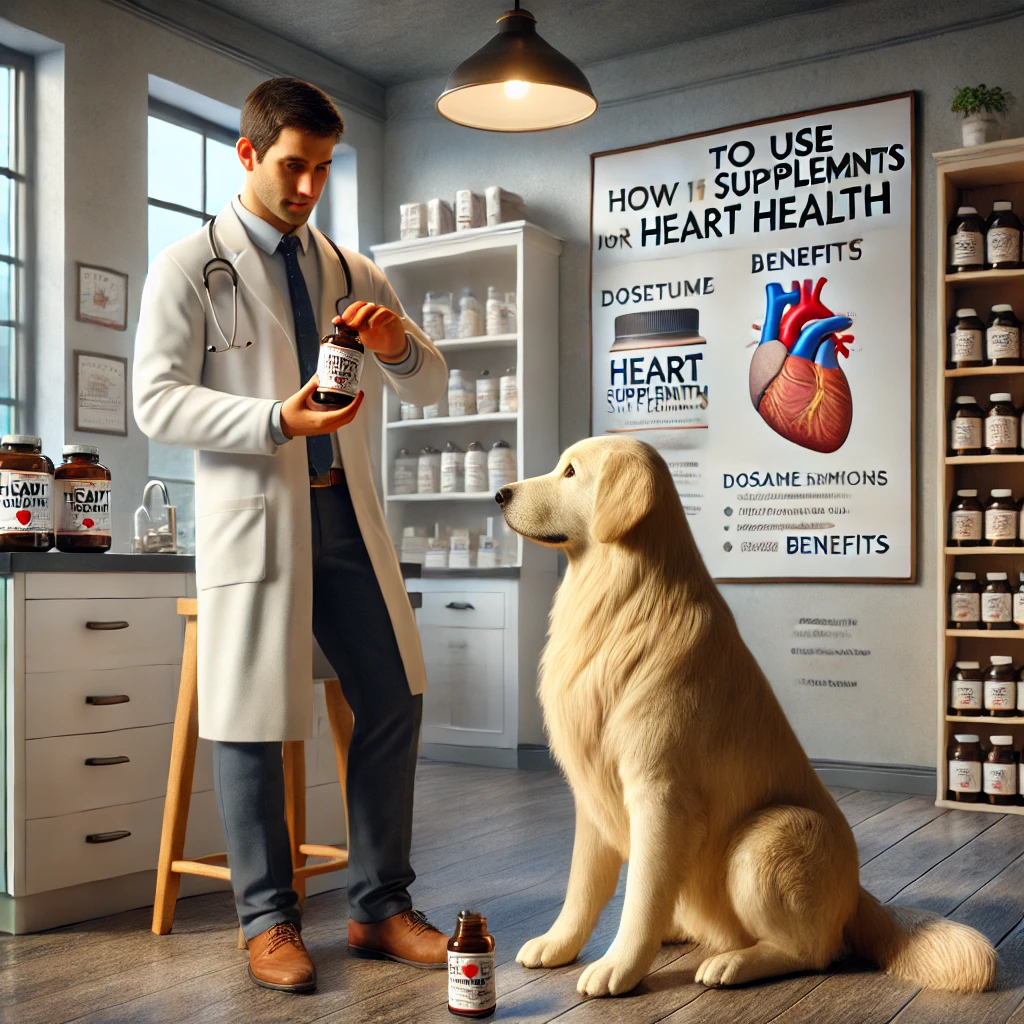
This table provides detailed instructions on how to administer supplements to adult and senior dogs to support heart health.
| Supplement | How to Use | Age Group |
|---|---|---|
| Omega-3 Fatty Acids | Add fish oil or flaxseed oil to food. Use dosage based on weight (consult your vet). | Adults, Seniors |
| Coenzyme Q10 (CoQ10) | Give chewable tablets or capsules. Follow dosage instructions (consult your vet). | Adults, Seniors |
| L-Carnitine | Use liquid or powder form. Mix into food. Follow vet-recommended dosage. | Adults, Seniors |
| Taurine | Use taurine supplements formulated for dogs. Follow dosage instructions. | Adults, Seniors |
| Hawthorn Berry | Use liquid drops or capsules. Mix into food or water. Follow vet-recommended dosage. | Adults, Seniors |
| Magnesium | Use magnesium supplements formulated for dogs. Follow vet-recommended dosage. | Adults, Seniors |
| Vitamin E | Give chewable tablets or liquid form. Follow dosage instructions on the label. | Adults, Seniors |
| Antioxidant Blends | Use dog-specific antioxidant supplements. Follow dosage instructions on the label. | Adults, Seniors |
Key Notes for Using Supplements
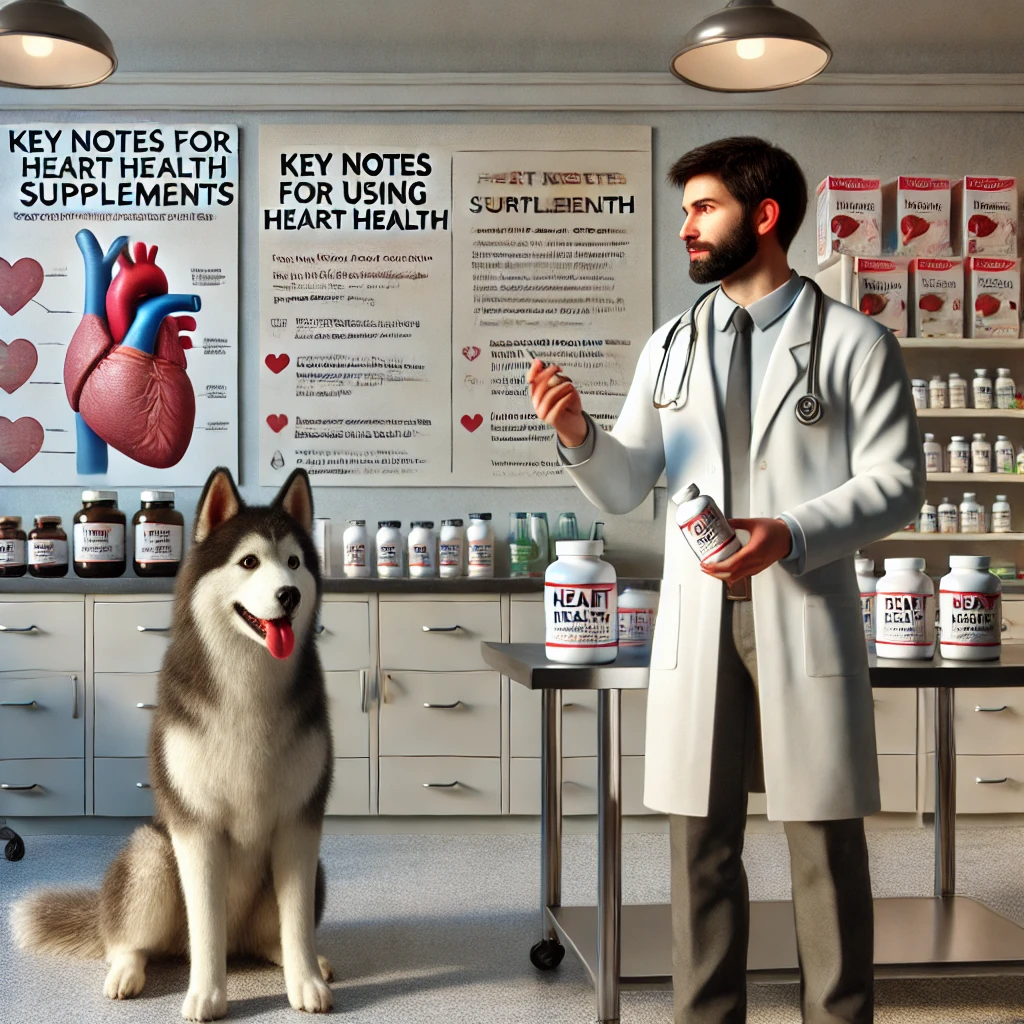
- Consult Your Vet:
- Always check with your veterinarian before starting any supplements.
- Dosage:
- Follow the recommended dosage based on your dog’s weight and age. Over-supplementation can be harmful.
- Monitor for Reactions:
- Watch for any adverse reactions like vomiting, diarrhea, or lethargy.
- Combine with a Healthy Lifestyle:
- Supplements should complement a balanced diet, regular exercise, and routine vet check-ups.
Prevention of Heart Failure in Dogs

- Regular Vet Visits:
- Early detection of heart disease is key.
- Heartworm Prevention:
- Use monthly preventatives to avoid heartworm disease.
- Healthy Diet:
- Feed a balanced, low-sodium diet.
- Exercise:
- Maintain a healthy weight and cardiovascular fitness.
- Breed-Specific Screening:
- For breeds prone to heart disease (e.g., Cavalier King Charles Spaniels, Dobermans).
Closing Statement

Heart failure is a serious but manageable condition in dogs. By understanding the causes, symptoms, and stages, you can provide the best care for your furry friend. Early detection, proper treatment, and lifestyle changes can significantly improve your dog’s quality of life and extend their survival time. Always consult your veterinarian for personalized advice and treatment options.
(FAQs) About Heart Failure in Dogs

Below are detailed answers to common questions about heart failure in dogs, including causes, symptoms, treatment, and prevention.
1. What is heart failure in dogs?
Heart failure occurs when the heart cannot pump blood effectively, leading to fluid buildup in the lungs, abdomen, or other tissues. It is often caused by underlying conditions like valvular disease, dilated cardiomyopathy, or heartworm disease.
2. What are the symptoms of heart failure in dogs?
Symptoms include:
- Coughing (especially at night or after exercise).
- Difficulty breathing or rapid breathing.
- Lethargy and reduced energy.
- Swelling in the abdomen or limbs.
- Fainting or collapse.
3. What causes an enlarged heart in dogs?
An enlarged heart can result from:
- Dilated Cardiomyopathy (DCM): Weakening and thinning of the heart muscle.
- Chronic Valve Disease: Leaky heart valves causing the heart to work harder.
- Hypertrophic Cardiomyopathy (HCM): Thickening of the heart muscle.
4. What are the signs of a dog dying of heart failure?
Signs include:
- Severe difficulty breathing or gasping.
- Blue or pale gums.
- Cold extremities (paws and ears).
- Loss of appetite.
- Extreme weakness or inability to stand.
5. What are the stages of congestive heart failure in dogs?
- Stage A: At-risk dogs with no symptoms.
- Stage B1: Structural heart disease with no symptoms.
-
Stage B2: Structural heart disease with mild symptoms.
-
Stage C: Overt heart failure with significant symptoms.
-
Stage D: End-stage heart failure with severe symptoms.
6. How long can a dog live with congestive heart failure?
With proper treatment, dogs in early stages can live 1-2 years. Dogs in end-stage heart failure may only survive weeks to months.
7. Can heart failure in dogs be cured?
Heart failure cannot be cured, but it can be managed with medications, diet, and lifestyle changes to improve quality of life and extend survival time.
8. What medications are used to treat heart failure in dogs?
- Diuretics: Reduce fluid buildup ( furosemide).
- ACE Inhibitors: Improve blood flow (enalapril).
- Pimobendan: Strengthens the heart’s pumping ability.
9. Are certain breeds more prone to heart failure?
Yes, breeds prone to heart failure include:
- Small Breeds: Cavalier King Charles Spaniels, Dachshunds.
- Large Breeds: Dobermans, Great Danes, Boxers.
10. Can supplements help prevent heart failure in dogs?
Yes, supplements like omega-3 fatty acids, CoQ10, taurine, and antioxidants can support heart health. Always consult your vet before starting supplements.
11. What is the best diet for a dog with heart failure?
A low-sodium diet with high-quality protein and omega-3 fatty acids is ideal. Avoid high-sodium treats and table scraps.
12. How can I prevent heart failure in my dog?
- Regular vet check-ups for early detection.
- Heartworm prevention.
- Feed a balanced, low-sodium diet.
- Maintain a healthy weight through exercise.
13. Can exercise help a dog with heart failure?
Moderate exercise is beneficial, but avoid overexertion. Consult your vet for a tailored exercise plan.
14. What is the life expectancy of a dog with heart failure?
Life expectancy depends on the stage and treatment. Early-stage dogs can live 1-2 years, while end-stage dogs may only survive weeks to months.
15. Can heartworm disease cause heart failure in dogs?
Yes, heartworm disease can damage the heart and lungs, leading to heart failure. Monthly preventatives are essential.
16. What are the signs of heartworm disease in dogs?
- Coughing.
- Difficulty breathing.
- Lethargy.
- Weight loss.
- Swollen abdomen.
17. Can heart failure in dogs be prevented?
While not all cases can be prevented, regular vet visits, heartworm prevention, and a healthy lifestyle can reduce the risk.
18. What is the cost of treating heart failure in dogs?
In a dog with mild or subtle clinical signs, costs typically include: Initial diagnostic testing (radiographs, bloodwork, echocardiogram): $1,000-$1,500. Monthly medications: $50-$150/month. Long-term monitoring (exams, bloodwork, radiographs): $500-$1,000/year.30-Oct-2024
19. When should I consider euthanasia for my dog with heart failure?
Consider euthanasia if your dog:
- Is in unmanageable pain.
- Has a poor quality of life (e.g., unable to eat, drink, or move).
- No longer responds to treatment.
20. How can I improve my dog’s quality of life with heart failure?
- Administer medications as prescribed.
- Provide a low-sodium, high-quality diet.
- Ensure moderate exercise and a stress-free environment.
- Regular vet check-ups to monitor the condition.
-

 SMALL DOG BREEDS4 months ago
SMALL DOG BREEDS4 months agoMerle Chihuahua: A Comprehensive Guide
-

 SMALL DOG BREEDS4 months ago
SMALL DOG BREEDS4 months agoMaltese: A Beloved Companion
-

 Large Breeds4 months ago
Large Breeds4 months agoSamoyeds Hypoallergenic: Closer Look at the Breed
-

 SMALL DOG BREEDS4 months ago
SMALL DOG BREEDS4 months agoMerle Pomeranian: A Adorable Companion
-

 Large Breeds4 months ago
Large Breeds4 months agoStandard Poodle Weight: Country Wise
-

 SMALL DOG BREEDS4 months ago
SMALL DOG BREEDS4 months agoYorkshire Terrier: a Big Personality
-

 MEDIUM BREEDS4 months ago
MEDIUM BREEDS4 months agoAmerican Water Spaniel Colors Chocolate In Crcols:
-

 Terrier Breeds3 months ago
Terrier Breeds3 months agoDog Breeds: by Country & Category





